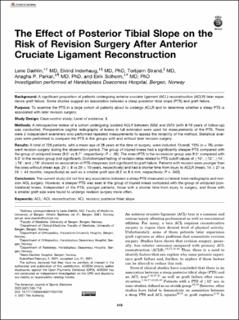| dc.description.abstract | Background:
A significant proportion of patients undergoing anterior cruciate ligament (ACL) reconstruction (ACLR) later experience graft failure. Some studies suggest an association between a steep posterior tibial slope (PTS) and graft failure.
Purpose:
To examine the PTS in a large cohort of patients about to undergo ACLR and to determine whether a steep PTS is associated with later revision surgery.
Study Design:
Case-control study; Level of evidence, 3.
Methods:
A retrospective review of a cohort undergoing isolated ACLR between 2002 and 2012 (with 8-19 years of follow-up) was conducted. Preoperative sagittal radiographs of knees in full extension were used for measurements of the PTS. There were 2 independent examiners who performed repeated measurements to assess the reliability of the method. Statistical analyses were performed to compare the PTS in the groups with and without later revision surgery.
Results:
A total of 728 patients, with a mean age of 28 years at the time of surgery, were included. Overall, 10% (n = 76) underwent revision surgery during the observation period. The group of injured knees had a significantly steeper PTS compared with the group of uninjured knees (9.5° vs 8.7°, respectively; P < .05). The mean PTS in the no revision group was 9.5° compared with 9.3° in the revision group (not significant). Dichotomized testing of revision rates related to PTS cutoff values of ≥10°, ≥12°, ≥14°, ≥16°, and ≥18° showed no association of PTS steepness (not significant) to graft failure. Patients with revision were younger than the ones without (mean age, 24 ± 8 vs 29 ± 10 years, respectively) and had a shorter time from injury to ACLR (mean, 14 ± 27 vs 24 ± 44 months, respectively) as well as a smaller graft size (8.2 vs 8.4 mm, respectively; P = .040).
Conclusion:
The current study did not find any association between a steep PTS measured on lateral knee radiographs and revision ACL surgery. However, a steeper PTS was seen in the group of injured knees compared with the group of uninjured (contralateral) knees. Independent of the PTS, younger patients, those with a shorter time from injury to surgery, and those with a smaller graft size were found to undergo revision surgery more often. | en_US |

